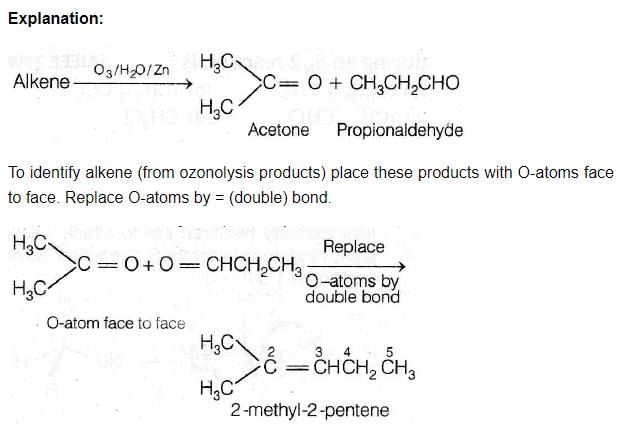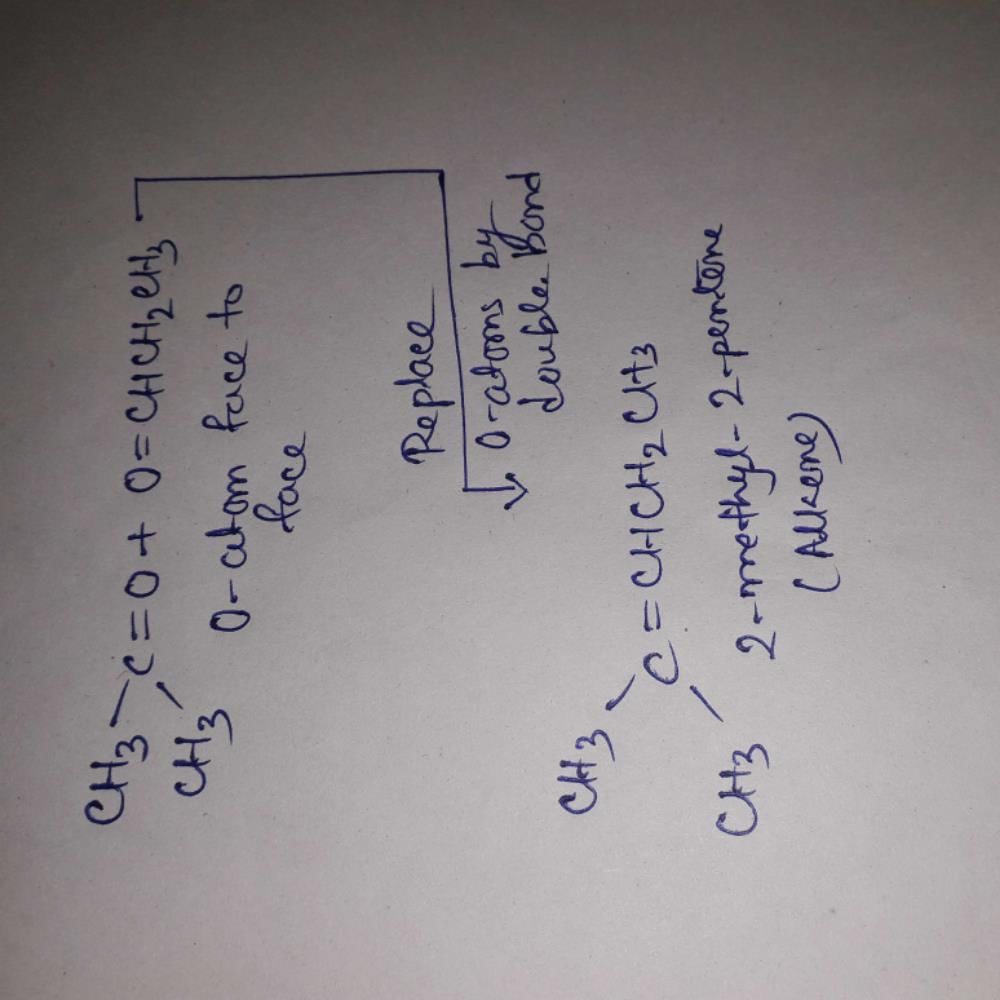Class 11 Exam > Class 11 Questions > Ozonolysis of an organic compound 'A'...
Start Learning for Free
Ozonolysis of an organic compound 'A' produces acetone and propionaldehyde in equimolar mixture. Identify 'A' from the following compounds
[AIEEE 2011]
- a)1 - Pentene
- b)2 - Methyl - 1 - pentene
- c)2 - Methyl - 2 - pentene
- d)2 - Pentene
Correct answer is option 'C'. Can you explain this answer?
| FREE This question is part of | Download PDF Attempt this Test |
Verified Answer
Ozonolysis of an organic compound 'A' produces acetone and pro...

Most Upvoted Answer
Ozonolysis of an organic compound 'A' produces acetone and pro...

Free Test
FREE
| Start Free Test |
Community Answer
Ozonolysis of an organic compound 'A' produces acetone and pro...
Explanation:
The given reaction is an ozonolysis reaction, which involves the cleavage of a carbon-carbon double bond by ozone (O3) followed by the reductive workup.
In this reaction, the organic compound A produces acetone and propionaldehyde in an equimolar mixture. We need to identify which of the given compounds can produce this equimolar mixture of products.
To determine the product of the ozonolysis reaction, we need to consider the different possible ways the carbon-carbon double bond can be cleaved.
The ozonolysis reaction proceeds through two main steps:
1. Formation of ozonide: Ozone reacts with the double bond to form an intermediate called an ozonide. The ozonide is a cyclic compound containing an O-O bond.
2. Cleavage of ozonide: The ozonide is then cleaved by a reductive workup, which results in the formation of carbonyl compounds.
Based on the given products (acetone and propionaldehyde), we can infer the following cleavage pattern:
- The carbon adjacent to the double bond in the starting compound must have three different alkyl groups attached to it, resulting in the formation of a ketone (acetone).
- The other carbon of the double bond must have two different alkyl groups attached to it, resulting in the formation of an aldehyde (propionaldehyde).
Analysis of the given compounds:
a) 1-Pentene: This compound does not have a carbon adjacent to the double bond with three different alkyl groups attached to it. Therefore, it cannot produce the required products.
b) 2-Methyl-1-pentene: This compound does have a carbon adjacent to the double bond with three different alkyl groups attached to it. However, the other carbon of the double bond also has two identical methyl groups attached to it. Therefore, it cannot produce the required products.
c) 2-Methyl-2-pentene: This compound has a carbon adjacent to the double bond with three different alkyl groups attached to it. The other carbon of the double bond also has two different alkyl groups attached to it. Therefore, it can produce the required products (acetone and propionaldehyde) in an equimolar mixture.
d) 2-Pentene: This compound does not have a carbon adjacent to the double bond with three different alkyl groups attached to it. Therefore, it cannot produce the required products.
Conclusion:
From the analysis above, we can conclude that the organic compound A is 2-Methyl-2-pentene (option C) as it can produce acetone and propionaldehyde in an equimolar mixture through ozonolysis reaction.
The given reaction is an ozonolysis reaction, which involves the cleavage of a carbon-carbon double bond by ozone (O3) followed by the reductive workup.
In this reaction, the organic compound A produces acetone and propionaldehyde in an equimolar mixture. We need to identify which of the given compounds can produce this equimolar mixture of products.
To determine the product of the ozonolysis reaction, we need to consider the different possible ways the carbon-carbon double bond can be cleaved.
The ozonolysis reaction proceeds through two main steps:
1. Formation of ozonide: Ozone reacts with the double bond to form an intermediate called an ozonide. The ozonide is a cyclic compound containing an O-O bond.
2. Cleavage of ozonide: The ozonide is then cleaved by a reductive workup, which results in the formation of carbonyl compounds.
Based on the given products (acetone and propionaldehyde), we can infer the following cleavage pattern:
- The carbon adjacent to the double bond in the starting compound must have three different alkyl groups attached to it, resulting in the formation of a ketone (acetone).
- The other carbon of the double bond must have two different alkyl groups attached to it, resulting in the formation of an aldehyde (propionaldehyde).
Analysis of the given compounds:
a) 1-Pentene: This compound does not have a carbon adjacent to the double bond with three different alkyl groups attached to it. Therefore, it cannot produce the required products.
b) 2-Methyl-1-pentene: This compound does have a carbon adjacent to the double bond with three different alkyl groups attached to it. However, the other carbon of the double bond also has two identical methyl groups attached to it. Therefore, it cannot produce the required products.
c) 2-Methyl-2-pentene: This compound has a carbon adjacent to the double bond with three different alkyl groups attached to it. The other carbon of the double bond also has two different alkyl groups attached to it. Therefore, it can produce the required products (acetone and propionaldehyde) in an equimolar mixture.
d) 2-Pentene: This compound does not have a carbon adjacent to the double bond with three different alkyl groups attached to it. Therefore, it cannot produce the required products.
Conclusion:
From the analysis above, we can conclude that the organic compound A is 2-Methyl-2-pentene (option C) as it can produce acetone and propionaldehyde in an equimolar mixture through ozonolysis reaction.
Attention Class 11 Students!
To make sure you are not studying endlessly, EduRev has designed Class 11 study material, with Structured Courses, Videos, & Test Series. Plus get personalized analysis, doubt solving and improvement plans to achieve a great score in Class 11.

|
Explore Courses for Class 11 exam
|

|
Similar Class 11 Doubts
Ozonolysis of an organic compound 'A' produces acetone and propionaldehyde in equimolar mixture. Identify 'A' from the following compounds[AIEEE 2011]a)1 - Penteneb)2 - Methyl - 1 - pentenec)2 - Methyl - 2 - pentened)2 - PenteneCorrect answer is option 'C'. Can you explain this answer?
Question Description
Ozonolysis of an organic compound 'A' produces acetone and propionaldehyde in equimolar mixture. Identify 'A' from the following compounds[AIEEE 2011]a)1 - Penteneb)2 - Methyl - 1 - pentenec)2 - Methyl - 2 - pentened)2 - PenteneCorrect answer is option 'C'. Can you explain this answer? for Class 11 2024 is part of Class 11 preparation. The Question and answers have been prepared according to the Class 11 exam syllabus. Information about Ozonolysis of an organic compound 'A' produces acetone and propionaldehyde in equimolar mixture. Identify 'A' from the following compounds[AIEEE 2011]a)1 - Penteneb)2 - Methyl - 1 - pentenec)2 - Methyl - 2 - pentened)2 - PenteneCorrect answer is option 'C'. Can you explain this answer? covers all topics & solutions for Class 11 2024 Exam. Find important definitions, questions, meanings, examples, exercises and tests below for Ozonolysis of an organic compound 'A' produces acetone and propionaldehyde in equimolar mixture. Identify 'A' from the following compounds[AIEEE 2011]a)1 - Penteneb)2 - Methyl - 1 - pentenec)2 - Methyl - 2 - pentened)2 - PenteneCorrect answer is option 'C'. Can you explain this answer?.
Ozonolysis of an organic compound 'A' produces acetone and propionaldehyde in equimolar mixture. Identify 'A' from the following compounds[AIEEE 2011]a)1 - Penteneb)2 - Methyl - 1 - pentenec)2 - Methyl - 2 - pentened)2 - PenteneCorrect answer is option 'C'. Can you explain this answer? for Class 11 2024 is part of Class 11 preparation. The Question and answers have been prepared according to the Class 11 exam syllabus. Information about Ozonolysis of an organic compound 'A' produces acetone and propionaldehyde in equimolar mixture. Identify 'A' from the following compounds[AIEEE 2011]a)1 - Penteneb)2 - Methyl - 1 - pentenec)2 - Methyl - 2 - pentened)2 - PenteneCorrect answer is option 'C'. Can you explain this answer? covers all topics & solutions for Class 11 2024 Exam. Find important definitions, questions, meanings, examples, exercises and tests below for Ozonolysis of an organic compound 'A' produces acetone and propionaldehyde in equimolar mixture. Identify 'A' from the following compounds[AIEEE 2011]a)1 - Penteneb)2 - Methyl - 1 - pentenec)2 - Methyl - 2 - pentened)2 - PenteneCorrect answer is option 'C'. Can you explain this answer?.
Solutions for Ozonolysis of an organic compound 'A' produces acetone and propionaldehyde in equimolar mixture. Identify 'A' from the following compounds[AIEEE 2011]a)1 - Penteneb)2 - Methyl - 1 - pentenec)2 - Methyl - 2 - pentened)2 - PenteneCorrect answer is option 'C'. Can you explain this answer? in English & in Hindi are available as part of our courses for Class 11.
Download more important topics, notes, lectures and mock test series for Class 11 Exam by signing up for free.
Here you can find the meaning of Ozonolysis of an organic compound 'A' produces acetone and propionaldehyde in equimolar mixture. Identify 'A' from the following compounds[AIEEE 2011]a)1 - Penteneb)2 - Methyl - 1 - pentenec)2 - Methyl - 2 - pentened)2 - PenteneCorrect answer is option 'C'. Can you explain this answer? defined & explained in the simplest way possible. Besides giving the explanation of
Ozonolysis of an organic compound 'A' produces acetone and propionaldehyde in equimolar mixture. Identify 'A' from the following compounds[AIEEE 2011]a)1 - Penteneb)2 - Methyl - 1 - pentenec)2 - Methyl - 2 - pentened)2 - PenteneCorrect answer is option 'C'. Can you explain this answer?, a detailed solution for Ozonolysis of an organic compound 'A' produces acetone and propionaldehyde in equimolar mixture. Identify 'A' from the following compounds[AIEEE 2011]a)1 - Penteneb)2 - Methyl - 1 - pentenec)2 - Methyl - 2 - pentened)2 - PenteneCorrect answer is option 'C'. Can you explain this answer? has been provided alongside types of Ozonolysis of an organic compound 'A' produces acetone and propionaldehyde in equimolar mixture. Identify 'A' from the following compounds[AIEEE 2011]a)1 - Penteneb)2 - Methyl - 1 - pentenec)2 - Methyl - 2 - pentened)2 - PenteneCorrect answer is option 'C'. Can you explain this answer? theory, EduRev gives you an
ample number of questions to practice Ozonolysis of an organic compound 'A' produces acetone and propionaldehyde in equimolar mixture. Identify 'A' from the following compounds[AIEEE 2011]a)1 - Penteneb)2 - Methyl - 1 - pentenec)2 - Methyl - 2 - pentened)2 - PenteneCorrect answer is option 'C'. Can you explain this answer? tests, examples and also practice Class 11 tests.

|
Explore Courses for Class 11 exam
|

|
Suggested Free Tests
Signup for Free!
Signup to see your scores go up within 7 days! Learn & Practice with 1000+ FREE Notes, Videos & Tests.
























